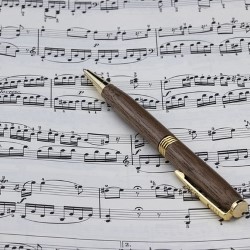When students are working on songs I take the minimal approach to writing things in the music. It makes sure they know what to really pay attention to. And I encourage them to write things in themselves once they have seen some examples of how I write practice reminders for them.
Many students will have a phase where they will pay little or no attention to a certain aspect of music - notes, fingerings, dynamics, etc. During this phase I write a general reminder really big at the top of the music "DYNAMICS." Or I will write a message like "READ THE NOTES FIRST." This will usually help the student give extra focus to that particular thing. As the student gets used to paying attention to more things in the music, they will start needing reminders just on certain notes, dynamics, fingerings etc. Then we graduate to circling individual things in the music.
When circling things to pay attention to during practice, it is important to figure out exactly which note, fingering, dynamic, etc. actually needs to be circled. To check on this, the student will play a new section or piece 3 or 4 times and will I verbally remind them of anything they are missing from the music. If they are missing a certain fingering every time, then we circle it. If they are missing a particular note every time then we circle it. I had a student just this week grab a pencil after we worked on a new part of a song and circle some fingerings she felt she needed extra reminders on - it was great!
Besides circling, adding arrows is another music marking tool that helps students improve their practice. If a student is continually moving up instead of down for a transition, we will write a straight downwards arrow in the music right before the transition. If they are going up instead of down for a note, we will write an angled arrow so they can see the note going up instead of down.
Another great practice reminder to write in the music is some information about the way they are playing something. For example, if thinking about jumping up the stairs helps them to get their staccatos nice and light, we will draw a picture of a stick person (or maybe even a bunny) hopping up some stairs. Then when they see the picture they will see something hopping up the stairs and it will give them something to imagine for their staccatos to sound and feel like.
Any time a student feels like they are done with a reminder they should erase it. That way the only markings on the music will be things they still need to pay attention to. I had a student once who was using some books from an older sibling that had lots of counting written in with pen, and lots of things circled. With so much on the page they were not sure what was important to pay attention to, so they ignored not only the written in stuff, but lots of the music and fingerings as well! So always use pencil and erase, erase, erase!
Once students have used this practice tool for a while it can increase their confidence greatly. Writing things in the music helps them know what to pay attention to and it gives them a better understanding of what their practice goals are.


